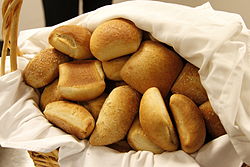
A bread roll is a small, often round loaf of bread served as a meal accompaniment, eaten plain or with butter. A roll can be served and eaten whole or cut transversely and dressed with filling between the two halves. Rolls are also commonly used to make sandwiches similar to those produced using slices of bread. A bun is a type of bread or bread roll, sometimes sweet. Buns come in many shapes and sizes, but are most commonly hand-sized or smaller, with a round top and flat bottom. The items listed here include both bread rolls and buns.
Contents
There are many names for bread rolls and buns, especially in local dialects of British English. The different terms originated from bakers, based on how they made the dough and how the items were cooked. Over time, people tend to use one name to refer to all similar products, regardless of whether or not it is technically correct by the original definitions.














